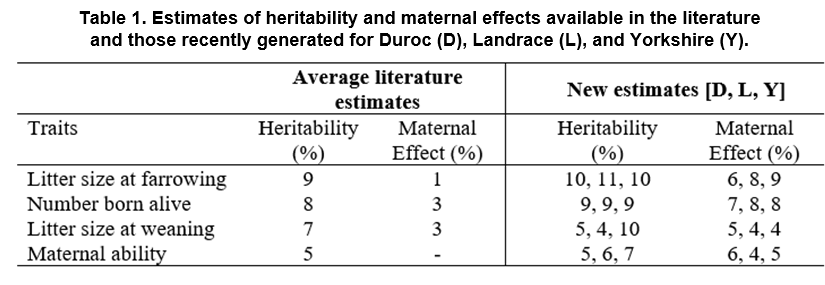Maternal effects can be defined as all conditions that relate to how a dam’s genetics and life history influences how her progenies perform. These conditions can be divided into:
- Pre-natal conditions such as the ability to conceive, establish and maintain pregnancy as well as the extent at which her uterine capacity may impact on litter size and piglets conditions at farrowing,
- Post-natal conditions including the ability of the dam to produce enough milk and her mothering instincts (Robinson, 1972; Alves et al., 2018).
Maternal effects represent a sizeable source of variation in the traits of growing pigs at pre and post-weaning stages. This source of variation could be a genetic factor, environmental factor, or both. Accounting for maternal effects in swine genetic evaluation programs is important for accurate estimation of breeding values for those traits with maternal influence.
However, accurately measuring maternal effects could be a challenge due:
- Maternal effects are only expressed later in the life of the sow and long after a selection decision was made on her as a gilt.
- An insufficient number of dams with multiple records can affect the ability to properly adjust for maternal effects in the genetic evaluation program.
- Maternal effects of a dam on traits of its young are often confounded by the dam’s direct contribution of genes to her progeny. For example, how fast a pig grows from birth to weaning is influenced by the piglets’ own genetic ability to grow which the piglet inherited from the sow plus the “maternal” effect provided by the sow.
- The use of cross-fostering affects the proper assessment of a dam’s maternal effect on its offspring because the maternal ability of the sow is often directly related to the reasons for cross-fostering.

Quantifying or accurately estimating maternal effects for genetic evaluation purposes requires an understanding of the relationship between dams and their daughters and the availability of multiple records on the same sow. Table 1 shows the percentage of variation in maternal traits that are heritable and the portion that is due to maternal effects. Here, the estimates are based on an average of previous research (Akanno et al., 2013) and a recent update generated from a pedigree-based relationship utilizing data for Duroc, Landrace and Yorkshire breeds of pigs.
The result also illustrates the importance of having the right data structure to properly account for maternal effects. Moreover, the availability of genomic information provides the opportunity to estimate maternal effects more accurately.
The caveat with this success in science is that genotyping many dams and their daughters to accurately estimate maternal effects is a costly venture. Nevertheless, Genesus Inc. is taking the lead by building a database of genotypes with accompanying phenotypes on many dams and daughters with repeated records. This information is used to estimate maternal effects more accurately in the Genesus genomic evaluation, thus improving the genetic merit of the breeding stock.

References:
Robison, O. W. (1972) The Role of Maternal Effects in Animal Breeding: V. Maternal Effects in Swine. Journal of Animal Science, Volume 35, Issue 6, December 1972, Pages 1303–1315, https://doi.org/10.2527/jas1972.3561303x
Alves, K., F. S. Schenkel, L. F. Brito, and A. Robinson (2018). Estimation of direct and maternal genetic parameters for individual birth weight, weaning weight, and probe weight in Yorkshire and Landrace pigs1. J. Anim. Sci. 2018.96:2567–2578, doi: 10.1093/jas/sky172
Akanno, E. C., F. S. Schenkel, V. M. Quinton, R. M. Friendship, J. A. B. Robinson (2013). Meta-analysis of genetic parameter estimates for reproduction, growth and carcass traits of pigs in the tropics. Livestock Science 152 (2013)101–113

Genesus Research and Development
The Genesus research and development program is focused on the continual improvement of our products and services. Our use of innovative technologies and time-tested methods ensure that our products and services provide our customers a competitive edge on today’s market
Genesus invites you behind the scenes to find out more about our programs and to show that we mean it when we ask you…
Are you ready to have the best pig in the world?
| Genesus R&D Booklet |





